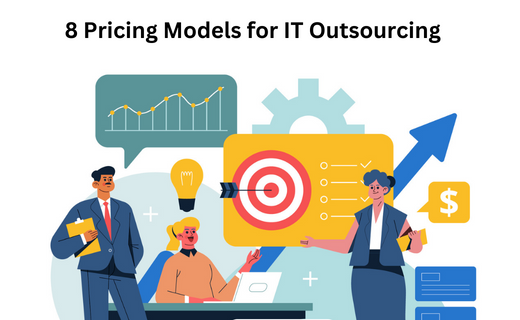-

8 Pricing Models for IT Outsourcing
Traditionally, most IT outsourcing companies have been billed based on time and materials or a fixed price. Outsourcing services have evolved from simple basic needs and services to more complex partnerships capable of generating innovation and transformation. The situation requires new contractual approaches, including managed services and more result-oriented arrangements. There are eight common ways to structure an outsourcing agreement:
Time and Materials
The time and materials pricing model is a type of billing in which the customer is charged based on the actual time and materials used to complete a project. This pricing model is often used when the project scope may be difficult to define upfront and the cost of materials used can vary significantly.
Under a time and materials pricing model, the customer is typically charged an hourly rate for the time spent working on the project and the cost of any materials used. The hourly rate may vary depending on the type of work being done and the skill level of the workers. The cost of materials is typically based on the actual cost of purchasing the materials, with no markup.
One advantage of the time and materials pricing model is that it allows project scope flexibility. If additional work is needed or the scope of the project changes, it can be easily accommodated under this pricing model. However, the disadvantage of this model is that it can be difficult to predict the total cost of a project upfront, which can be a concern for customers who want to budget for the work.
On-demand Pricing
On-demand pricing is a pricing model in which the customer pays for IT services on an as-needed basis rather than paying a fixed fee for a set amount of service. This model is often used in IT outsourcing, where a company contracts with an external vendor to provide IT services on an as-needed basis.
Under an on-demand pricing model, the customer typically pays a fee for each service or resource. For example, the customer may pay a fee for each hour of IT support provided or for each server or storage device used. The cost of the service is typically based on the actual resources used, with no upfront fees or long-term contracts.
On-demand pricing can be a flexible and cost-effective option for companies that need IT services irregularly or unpredictably. It allows the customer to pay only for the services they use rather than committing to a fixed fee for a set amount of service.
However, the disadvantage of this model is that it may not be as cost-effective for companies that need a large volume of IT services regularly, as they may be able to negotiate a better rate with a long-term contract.
Fixed Pricing
Fixed pricing is a pricing model in which the customer pays a fixed fee for a set amount of IT services. This model is often used in IT outsourcing, where a company contracts with an external vendor to provide IT services long-term.
Under a fixed pricing model, the customer pays a predetermined fee for a set amount of IT services. This may include a certain number of support hours, server or storage devices, or a certain amount of data transfer. The cost of the services is typically based on the volume of services provided rather than the actual resources used.
One advantage of fixed pricing is that it allows the customer to budget for IT services in advance and know exactly what they will be paying. It can also be more cost-effective for companies that regularly need a large volume of IT services, as they can negotiate a lower rate with a long-term contract.
However, the disadvantage of this model is that it may not be as flexible as other pricing models, as the customer is committed to a set amount of service regardless of their actual needs. It may also be less cost-effective for companies with fluctuating IT needs, as they may pay for services they do not use.
Cost-plus Pricing
Cost plus pricing is a pricing model in which the customer is charged for the actual cost of providing IT services plus a markup or profit margin. This model is often used in IT outsourcing, where a company contracts with an external vendor to provide IT services.
Under a cost-plus pricing model, the vendor calculates the cost of providing the IT services, including labor, materials, and overhead. This cost is multiplied by a markup percentage to determine the final price. For example, if the cost of providing IT services is $100 and the markup percentage is 20%, the final price would be $120.
One advantage of cost-plus pricing is that it allows the customer to see exactly how the price is calculated and what they are paying for. It can also be more transparent than other pricing models, as the customer knows exactly what they are paying for and what the vendor is making in profit.
However, the disadvantage of this model is that it may not be as cost-effective as other pricing models, as the customer is paying for the actual cost of the services plus a markup. It may also be less predictable, as the cost of the services may vary depending on the actual resources used.
Performance-based Pricing
Performance-based pricing is a pricing model in which the customer is charged based on the performance or outcomes of the IT services provided. This model is often used in IT outsourcing, where a company contracts with an external vendor to provide IT services.
Under a performance-based pricing model, the vendor typically sets specific performance targets or milestones that must be met for the customer to be charged. For example, the vendor may agree to provide a certain uptime for the customer's servers in exchange for a fixed fee, or they may decide to improve the customer's website performance in exchange for a percentage of the resulting increase in online sales.
One advantage of performance-based pricing is that it aligns the interests of the vendor and the customer, as both parties are motivated to achieve the agreed-upon performance targets. It can also be more cost-effective for the customer, as they only pay for the services if the desired performance is achieved.
However, the disadvantage of this model is that it may be difficult to predict the total cost of the services upfront, as it depends on the actual performance achieved. It may also be difficult to measure the performance accurately and fairly, leading to disputes between the vendor and the customer.
Gain-sharing Pricing
Gain-sharing pricing is a pricing model in which the customer and the vendor share the financial benefits of the IT services. This model is often used in IT outsourcing, where a company contracts with an external vendor to provide IT services.
Under a gain-sharing pricing model, the customer and the vendor agree on performance targets or metrics to measure the IT services' financial benefits. The vendor is typically paid a fixed fee for providing the services, and the customer shares a portion of the resulting financial benefits with the vendor.
For example, the vendor may agree to improve the customer's website performance in exchange for a percentage of the consequent increase in online sales.
One advantage of gain-sharing pricing is that it aligns the interests of the vendor and the customer, as both parties are motivated to achieve the agreed-upon performance targets. It can also be more cost-effective for the customer, as they only pay for the services if the desired performance is achieved.
However, the disadvantage of this model is that it may be difficult to predict the total cost of the services upfront, as it depends on the actual performance achieved. It may also be difficult to measure the performance accurately and fairly, leading to disputes between the vendor and the customer.
Shared Risk-Reward Pricing
A shared risk-reward is a pricing model in which the customer and the vendor share in the risks and rewards of the IT services provided. This model is often used in IT outsourcing, where a company contracts with an external vendor to provide IT services.
Under a shared risk-reward pricing model, the customer and the vendor agree on a set of performance targets or metrics that will be used to measure the success of the IT services. The vendor is typically paid a fee for providing the services, but the fee amount may vary based on whether the performance targets are met.
For example, the vendor may agree to improve the customer's website performance in exchange for a higher fee if the performance targets are met but a lower fee if the targets are not met.
One advantage of shared risk-reward pricing is that it aligns the interests of the vendor and the customer, as both parties are motivated to achieve the agreed-upon performance targets. It can also be more cost-effective for the customer, as they only pay a higher fee if the desired performance is achieved.
However, the disadvantage of this model is that it may be difficult to predict the total cost of the services upfront, as it depends on the actual performance achieved. It may also be challenging to measure the performance accurately and fairly, leading to disputes between the vendor and the customer.
Which Pricing Model is Best for Your Next Project?
There are several factors to consider when deciding which pricing model to choose in IT outsourcing:
- Business needs: The pricing model should align with the company's business needs and objectives. For example, a fixed pricing model may be more cost-effective if the company regularly needs a large volume of IT services. A time and materials pricing model may be more flexible if the company has fluctuating IT needs.
- Budget: The pricing model should be affordable for the company and fit within their budget. Companies should consider the total cost of the IT services, including any fees or markups, and compare the costs of different pricing models.
- Risk tolerance: Companies should consider their risk tolerance when choosing a pricing model. For example, a fixed pricing model may be less risky as it provides a predictable cost. In contrast, a performance-based pricing model may be riskier as the cost depends on the actual performance achieved.
- Vendor reputation: Companies should consider the reputation and track record of the vendor when choosing a pricing model. A reputable vendor with a history of successful projects is more likely to deliver high-quality IT services.
- Contract terms: Companies should carefully review the contract terms of the pricing model, including any fees or penalties, to ensure that they are fair and reasonable.
Overall, the best pricing model will depend on the specific needs and objectives of the company and the specific terms offered by the vendor. Companies should carefully evaluate the different pricing models and consider the pros and cons of each before making a decision.
ExpertTal can help you find the right IT experts for your next project and build remote development teams that empower you to grow your business. Discover what you can accomplish with us today!
Follow us on LinkedInAbout the Author

Kamal Rastogi is a serial IT entrepreneur with 25 yrs plus experience. Currently his focus area is Data Science business, ERP Consulting, IT Staffing and Experttal.com (Fastest growing US based platform to hire verified / Risk Compliant Expert IT resources from talent rich countries like India, Romania, Philippines etc...directly). His firms service clients like KPMG, Deloitte, EnY, Samsung, Wipro, NCR Corporation etc in India and USA.